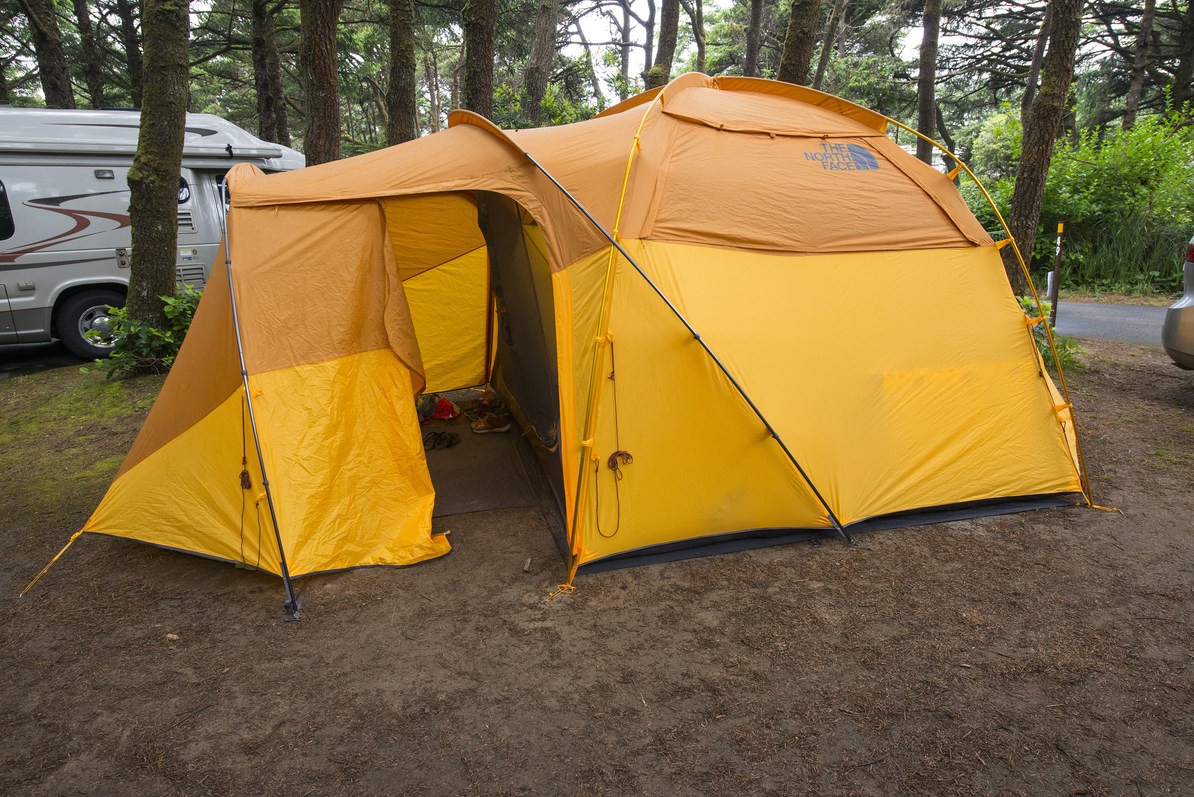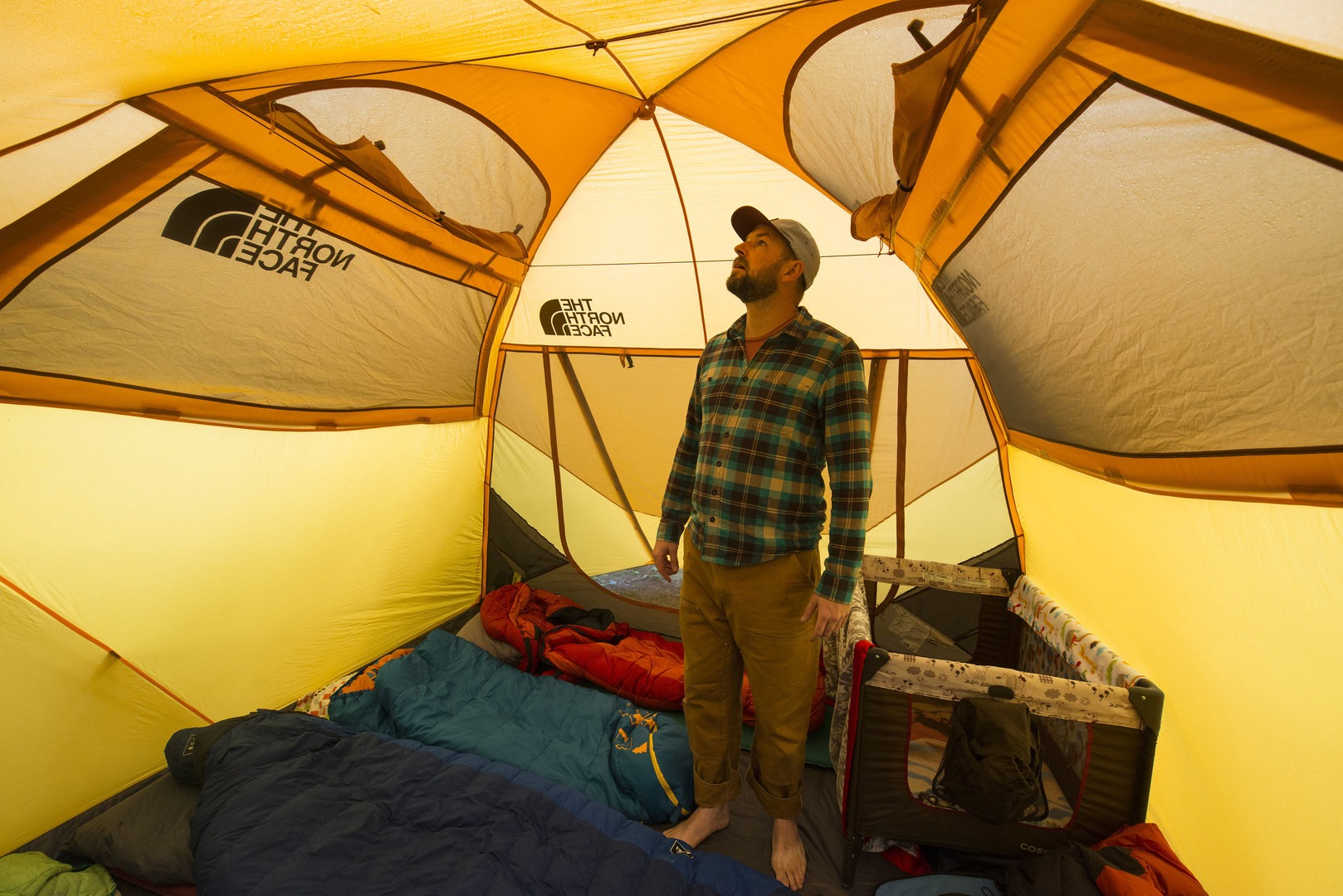The North Face Wawona 6 Tent specs
- 20 lbs 15 oz / 9.5 kg weight
- 80 inch / 203.2 cm max interior height
- 10 x 27 inches / 25.4 x 81.3 cm packed size
- 86 sq ft / 8 sq m floor area
- 45 sq ft / 4.2 sq m and 21 sq ft / 2 sq m vestibule combined area
- 3 doors
- 3-season
- 6-person
Where to get it
- Price: $399.00 for the tent and $65.00 for the footprint
- The North Face: Tent and footprint
- REI: Tent and footprint
- Moosejaw: Tent and footprint
The Bottom Line: Purchasing a family tent is like purchasing a minivan (for the record I own a Toyota Sienna): You're focused on practicality, carrying capacity, storage space, affordability, and if you're lucky, it will look good too. The North Face Wawona 6 Tent accomplishes all of those objectives along with a design aesthetic that makes it look as though it could be a four-season tent deep in the backcountry. This legacy California brand offering easily makes the Wawona 6 the cream of the crop when it comes to family tents on the market.

The North Face Wawona 6 Family Tent. Photo by Tyson Gillard.
Once our family expanded to include two kids (one in a pack-n-play) and an 80-pound dog, we decided that an upgrade from our three-person lightweight backpacking tent to a large six-person "family tent" was well overdue. It was nice to see that there were quite a few solid options for high-quality tents to choose from, and many came with a lower price tag than either of our backpacking tents. The decision to purchase The North Face Wawona 6 was pretty easy and clear because for some important reasons:
- Max interior height: I'm 6 feet, 2 inches tall, so head height was key to comfort.
- Vestibule area: We live in the Pacific Northwest, which receives lots of rain, so keeping a lot of things dry and protected was key.
- Price: This was going to be a gift from my in-laws. We were appreciative of their offer, but we also didn't want to overextend them.
Here's how the Wawona 6 tent stacked up on those three variables compared to some of the other tents we compared:
- The North Face Wawona 6: 80 inch max height, 76 square foot total vestibule area, $399.
- REI Kingdom 6: 75 inch max height, 29 square foot total vestibule area, $439.
- Big Agnes Big House 6: 78 inch max height, 0 square foot total vestibule area, $399.
- Marmot Limestone 6P: 76 inch max height, 25 square foot total vestibule area, $489.
- Kelty Camp Cabin 6: 81 inch max height, 0 square foot total vestibule area, $289.
- Big Agnes Tensleep Station 6: 75 inch max height, 49 square foot total vestibule area, $499.
- Big Agnes Flying Diamond 6: 67 inch max height, 32 square foot total vestibule area, $699.
- NEMO Wagontop 6P: 80 inch max height, 27 square foot total vestibule area, $649.
At nearly 21 pounds, this is no lightweight tent. This is a pure car-camping behemoth despite its backcountry-ready appearance. In fact, we swapped out the manufacturer's provided duffel sack for an extra backpacking pack we had laying around in the basement so that we could schlep this beast of a tent from house to car to campsite with more ease.
When comparing it to our three-person lightweight backpacking tents, we were surprised that setting up the Wawona 6 was definitely a two-person job even though it required virtually all the same steps and snaps. It's sheer size, weight and wind load (think of it as a kite) in particular made it impossible for only one person to set up, which is an important consideration when you have two kids tromping around the campsite that may require a helping hand.
Beyond the three most important purchasing variables listed above, the fourth element that we've appreciated the most is the tent's smart single-wall design. When fully zipped up, the Wawona 6 looks like a rugged four-season tent from the outside, but set up, take down, and storage are greatly simplified by eliminating a rain fly. With large mesh wall, windows, kickstand vents, and fully opening vestibules, however, the tent converts to a breezy summertime-ready sleep space in no time.
Other elements of the construction and design we've enjoyed are the large and plentiful mesh pockets, internal clothes drying lines, a footprint mat that extends into the vestibule area, and the 14 millimeter aluminum poles are relatively light and feel like they'll last a lifetime.
Opportunities for improvement are minimal, but a stuff sack with shoulder straps and a robust zipper (not a middle-expanding drawstring) would be nice for the next iteration.





Comments
Sign In and share them.